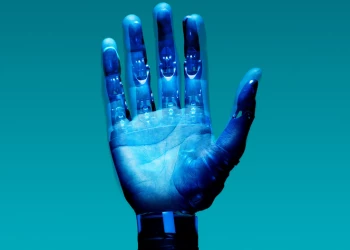Will AI replace most customer service teams by 2034?
As more companies use natural staff turnover to accelerate the shift to AI, Nick Glimsdahl explores the future of customer service
Add bookmarkListen to this content
Audio conversion provided by OpenAI

Imagine walking into a customer service department in 2034. What do you see? A room full of human agents, or a suite of advanced AI systems with just a handful of human overseers? As AI technology rapidly evolves, we're compelled to ask a critical question: Will AI replace most (51 percent) of customer service teams by 2034?
This provocative question challenges us to envision the future of customer service and consider the implications for businesses, employees, and customers alike. While some industry experts suggest this level of AI adoption is possible, others argue that the human touch in customer service will remain irreplaceable.
In this article, we'll explore both sides of this debate, examining the potential path to an AI-dominated customer service landscape and the factors that might accelerate or hinder this transition.
Don't miss any news, updates or insider tips from CX Network by getting them delivered to your inbox. Sign up to our newsletter and join our community of experts.
Understanding the 51 percent threshold: What would it mean?
If AI were to replace 51 percent of customer service teams by 2034, we might see:
AI-first service models: The majority of initial customer interactions are handled entirely by AI, from chatbots to voice assistants.
Human agents as specialists: Remaining human agents focusing on complex, high-value interactions requiring emotional intelligence and creative problem-solving.
Hybrid teams: AI and humans working in tandem, with AI supporting human agents in real-time during customer interactions.
But is this scenario realistic? Let's examine the factors that could drive us toward or away from this future.
The path to 2034: Key milestones
For AI to potentially reach this 51 percent threshold, several technological advancements would likely need to occur:
2025: Advanced NLP
AI understanding and responding to customer queries with near-human accuracy.
2028: Emotional intelligence in AI
AI systems recognizing and responding appropriately to customer emotions.
2031: Autonomous problem resolution
AI independently solving complex customer issues across multiple domains.
2034: Seamless AI-human collaboration
AI and human agents working together so smoothly that customers might not distinguish between them.
The economic case: Driving forces behind AI adoption
Several economic factors could push businesses toward greater AI adoption in customer service:
Cost efficiency: McKinsey estimates that AI technologies could deliver up to $1 trillion of additional value each year in the global banking industry alone.
Productivity boost: Accenture suggests AI-powered customer service could increase productivity by 30-50 percent.
24/7 Availability: AI systems providing round-the-clock service without additional labor costs.
Reduced error rates: Properly trained AI systems potentially reducing costly human errors.
Economic disruption: The shift potentially leading to job displacement, necessitating economic planning and workforce retraining.
The human element: Why 51 percent might not happen
Despite the potential benefits, several factors could prevent AI from replacing the majority of customer service teams:
Emotional intelligence: Some argue that AI may never fully replicate human empathy and emotional connection.
Complex problem solving: Unique or unprecedented issues might still require human creativity and intuition.
Customer preference: Some customers may always prefer interacting with humans, especially for sensitive matters.
Ethical concerns: Issues around AI transparency, data privacy, and potential biases could slow adoption.
Regulatory hurdles: Future regulations might limit the extent of AI use in customer interactions.
The role of customer expectations
Another critical factor in determining whether AI will replace 51 percent of customer service teams by 2034 is customer expectations. As customers become more tech-savvy, their preferences for service channels and interactions may shift:
Digital natives: By 2034, a large portion of the customer base will be digital natives who may prefer quick, efficient AI interactions for simple queries.
Personalization demands: Paradoxically, customers may also expect highly personalized service, which could either drive AI adoption (if AI can provide superior personalization) or limit it (if human agents are perceived as better at personalization).
Trust in AI: Customer trust in AI-driven service will play a crucial role. If AI consistently outperforms human agents in accuracy and efficiency, customer preferences could shift dramatically towards AI.
Complexity of issues: As products and services become more complex, customers may increasingly value human expertise for handling intricate problems, potentially limiting AI's role in some areas.
7 steps to prepare for an uncertain future
Regardless of whether AI reaches the 51 percent threshold by 2034, businesses should prepare for increased AI integration in customer service. Here's how:
- Invest in AI education: Develop AI literacy programs for your customer service team.
- Start gradual AI integration: Identify areas where AI can immediately improve your customer service.
- Evolve human roles: Train your team for high-value, complex interactions that AI can't handle.
- Develop an AI ethics framework: Create guidelines for responsible AI use in customer interactions.
- Focus on data quality: Improve your customer data collection and management practices.
- Foster a continuous learning culture: The skills needed in 2034 will likely be vastly different from today's.
- Maintain flexibility: Stay agile in your approach, ready to adapt to technological leaps and regulatory changes.
The future is collaborative
Whether AI will replace 51 percent of customer service teams by 2034 remains to be seen. The reality will likely depend on advances in AI technology, economic pressures, customer preferences, and regulatory environments.
What seems certain, however, is that AI will play an increasingly significant role in customer service. The most successful businesses will be those that find the right balance between AI efficiency and human touch, creating a symbiotic relationship where each enhances the other.
As we move towards 2034, the question isn't just whether AI will transform your customer service team, but how you'll leverage this transformation to delight your customers and stay ahead of the competition. By starting to prepare now, you can help shape the future of customer service, whatever it may hold.
The path to 2034 is likely to be one of gradual transformation rather than overnight revolution. It will require ongoing assessment of AI capabilities, customer preferences, and the unique value that human agents bring to customer interactions. Companies that can navigate this balance, continuously adapting their approach as technology and customer expectations evolve, will be best positioned to thrive in the customer service landscape of 2034 and beyond.
What role do you think AI will play in your customer service team by 2034? How might this vary across different customer segments? And more importantly, how are you preparing for that future today?
Quick links
- The ethical AI guide for customer experience
- Klarna doubles down on AI ahead of IPO
- How to grow your customer base in 2024























